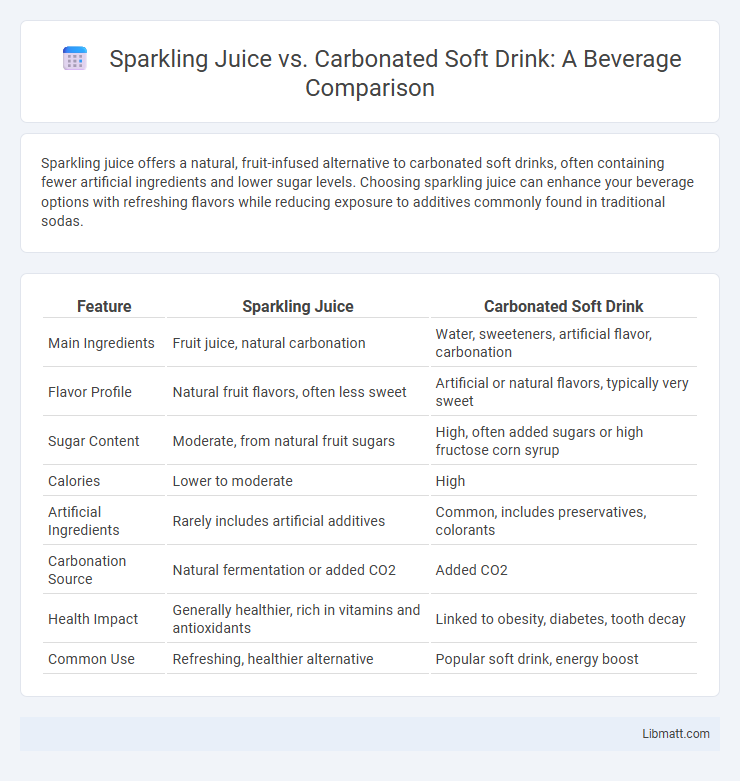Sparkling juice offers a natural, fruit-infused alternative to carbonated soft drinks, often containing fewer artificial ingredients and lower sugar levels. Choosing sparkling juice can enhance your beverage options with refreshing flavors while reducing exposure to additives commonly found in traditional sodas.
Table of Comparison
| Feature | Sparkling Juice | Carbonated Soft Drink |
|---|---|---|
| Main Ingredients | Fruit juice, natural carbonation | Water, sweeteners, artificial flavor, carbonation |
| Flavor Profile | Natural fruit flavors, often less sweet | Artificial or natural flavors, typically very sweet |
| Sugar Content | Moderate, from natural fruit sugars | High, often added sugars or high fructose corn syrup |
| Calories | Lower to moderate | High |
| Artificial Ingredients | Rarely includes artificial additives | Common, includes preservatives, colorants |
| Carbonation Source | Natural fermentation or added CO2 | Added CO2 |
| Health Impact | Generally healthier, rich in vitamins and antioxidants | Linked to obesity, diabetes, tooth decay |
| Common Use | Refreshing, healthier alternative | Popular soft drink, energy boost |
Introduction to Sparkling Juice and Carbonated Soft Drinks
Sparkling juice is a beverage made from natural fruit juice infused with carbon dioxide, offering a refreshing, fruity alternative to traditional carbonated soft drinks, which typically contain high levels of added sugars, artificial flavors, and preservatives. Sparkling juices provide vitamins and antioxidants inherent in fruit juice, making them a healthier choice compared to many carbonated soft drinks that are often linked to increased sugar consumption and related health risks. Your selection between the two can impact hydration and nutritional intake throughout the day.
Key Ingredients: What’s Inside Each Beverage?
Sparkling juice contains natural fruit juice and carbonated water, offering vitamins and antioxidants from real fruit extracts, with minimal added sugars or artificial ingredients. Carbonated soft drinks primarily consist of carbonated water, high fructose corn syrup or sugar, artificial flavors, and colors, often lacking nutritional value and containing caffeine or preservatives. The key ingredient distinction is the presence of natural fruit components in sparkling juice versus synthetic additives dominating carbonated soft drinks.
Sugar Content Comparison
Sparkling juice typically contains natural sugars derived from fruit concentrates, resulting in lower added sugar levels compared to carbonated soft drinks, which often have high fructose corn syrup or other sweeteners. Many carbonated soft drinks contain upwards of 30 to 40 grams of sugar per 12-ounce serving, while sparkling juices average around 10 to 20 grams for the same volume. Choosing sparkling juice can reduce excessive sugar intake, supporting better blood sugar control and overall health.
Calorie Count: Which Is Lighter?
Sparkling juice typically contains fewer calories than traditional carbonated soft drinks because it is often made with natural fruit extracts and less added sugar. Your choice for a lighter beverage should consider that many carbonated soft drinks are high in added sugars and calories, contributing to weight gain and other health issues. Opting for sparkling juice can provide a refreshing, lower-calorie alternative while still offering a bubbly, flavorful experience.
Use of Artificial Flavors and Preservatives
Sparkling juice often contains natural fruit extracts and minimal artificial flavors, prioritizing a more authentic taste profile compared to carbonated soft drinks, which typically use a higher concentration of artificial flavors and preservatives to enhance shelf life and flavor consistency. The use of preservatives like sodium benzoate and potassium sorbate is more common in carbonated soft drinks to prevent microbial growth, while sparkling juice may rely on pasteurization and natural antioxidants for preservation. Consumers seeking beverages with fewer synthetic additives generally prefer sparkling juice for its cleaner label and perceived health benefits.
Health Benefits and Concerns
Sparkling juice offers natural vitamins and antioxidants derived from fruit content, supporting immune health and providing essential nutrients without added synthetic chemicals. Carbonated soft drinks typically contain high levels of added sugars, artificial sweeteners, and preservatives, which may contribute to obesity, diabetes, and dental erosion. Choosing sparkling juice can reduce exposure to harmful additives while promoting hydration with a flavorful alternative rich in phytochemicals and lower glycemic impact.
Taste and Texture Differences
Sparkling juice offers a naturally fruity flavor with a subtle sweetness and light carbonation that provides a gentle, refreshing fizz. In contrast, carbonated soft drinks typically have a sharper, more pronounced carbonation and a sweeter, sometimes artificially flavored taste with a thicker, syrupy texture. The texture of sparkling juice tends to be smoother and less syrupy, enhancing its natural juice essence compared to the often heavier mouthfeel of carbonated soft drinks.
Market Trends and Popular Brands
The sparkling juice market has experienced significant growth driven by increasing consumer demand for healthier, natural beverage alternatives, with brands like Welch's, Martinelli's, and Izze leading the segment. In contrast, the carbonated soft drink market remains dominated by major brands such as Coca-Cola, Pepsi, and Dr Pepper, despite facing challenges from health-conscious consumers shifting preferences. Market trends highlight a rising preference for low-sugar, organic, and functional sparkling juices, whereas carbonated soft drinks focus on innovation through new flavors and reduced-calorie versions to retain market share.
Suitability for Different Age Groups
Sparkling juice, made from natural fruit juices and often containing fewer additives, is generally more suitable for children and health-conscious adults due to its lower sugar content and absence of artificial flavors. Carbonated soft drinks typically contain higher levels of sugar, caffeine, and artificial ingredients, making them less ideal for young children and individuals sensitive to stimulants. Parents and healthcare professionals often recommend sparkling juice as a safer, more nutritious alternative for a wider range of age groups.
Final Verdict: Making the Healthier Choice
Sparkling juice offers a healthier alternative to carbonated soft drinks by providing natural fruit flavors and essential vitamins with significantly less added sugar and no artificial sweeteners. Carbonated soft drinks contain high levels of refined sugars and empty calories that contribute to obesity and metabolic issues. Choosing sparkling juice supports better hydration and nutrient intake while reducing the risk of chronic diseases linked to excessive soda consumption.
Sparkling juice vs carbonated soft drink Infographic

 libmatt.com
libmatt.com